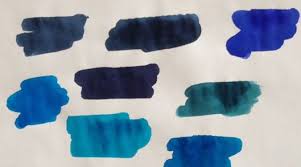Time for me to confess my hobby. I collect and use fountain pens. I have no memory of how I first got into this particular way of writing. No, it has nothing to do with the fabled “Today I am a fountain pen” bar mitzvah speech (though, having gone to many vintage pen shows, I can attest to the fact that many a bar mitzvah gift has wound up on the sales tables).
As a fountain pen user, I use bottled ink. I use a lot of blue inks. Probably too many. It’s because I’ve been searching for the perfect blue ink — the precisely right shade. I am not alone; this is a common theme among pen lovers.
People actually argue about this stuff. Part of those arguments include kaddishes for some beloved blue inks that are no longer available – except to Ebay prowlers, perhaps. Parker Penman, for example, is a cult favorite. It is in ink heaven somewhere – hopefully being used by God to write the names of the righteous in the Book of Life.
It has occurred to me that my search for the “perfect” blue is just a modern, secular version of Judaism’s frustrated and frustrating search for the “real” and historically accurate shade of the biblical techelet. That was the color of a yarn that was used in the ancient Tabernacle, the portable wilderness sanctuary, which makes it first appearance in this week’s Torah portion, Terumah.
Why don’t we know what techelet “really” looked like?
For one thing, we don’t know what its source was. Techelet comes from a dye that is made from the blood of a shellfish called “chilazon.” It lived in the Mediterranean Sea.
But the chilazon is extinct, and therefore, lost. At the Temple Institute in the Jewish Quarter in Jerusalem, there is a museum that contains what they believe to be the ritual items that were found in the ancient Temple. There is a snail in a display case. They say that this is the chilazon.
Is that true? Who knows?
So, what did techelet look like?
Some say that techelet resembled the color of the sea.
Fine – but different seas have different colors. The Atlantic Ocean; Long Island Sound; the Caribbean; the Gulf of Mexico….Some of those “seas” are more grey than anything else. So, some ancient sages say that techelet was somewhere between green and blue.
Some say that techelet was a sky blue.
Fine — but which sky? Early morning? Afternoon? Dusk? Was techelet a “real” blue, or a purplish blue?
Once upon a time there was a fringe of techelet on the tzitzit (ritual fringes).
Not anymore. But in 1888, Gershon Ḥanokh Leiner, the Hasidic rabbi of Radzin, proposed the re-introduction of the mitzvah of techelet. He went so far as to identify the chilazon as the cuttlefish, Sepia officinalis (vulgaris), which has a gland in its body that secretes a blue-black dye.
I have a tallit that contains various shades of blue and violet and indigo and purple. Each one, I assume, is a possible candidate for “true” techelet.
A few years ago, a headline in Haaretz proclaimed: “Fragment containing ancient ‘tekhelet’ dye discovered near Dead Sea.” It resembles a blue denim.
Blue denim? A purplish blue? A greenish blue? Teal? Navy blue? Go to the paint department at Home Depot, and look at the swatches — and you will know how frustrating this all is.
Actually, I love the fact that we just don’t know the real color of techelet.
Think of all those things in the Bible that we just don’t know.
- The name of Cain’s wife.
- The name of Noah’s wife.
- The name of Abraham’s mother. Are you surprised that if the biblical authors were going to lose or forget someone’s name, it will probably be a woman’s name?
- What happened to the Ten Tribes. How do you just lose ten whole tribes?
- The pronunciation of God’s Four Letter Name.
Not only that. How about:
- Why do righteous people suffer?
- For that matter, why do evil people prosper?
- When is the Messianic Age coming?
- What is the best solution to the Israel-Palestinian standoff?
The mysteries keep coming. The unanswerable questions still bug us.
Like this one: “Rabbi, when do you think we will be back in the sanctuary? When do you think we will be able to be physically together again, as a community — and not just on screen?”
My learned and expert answer: “I just don’t know.”
The ancient sages put it this way: “Teach your tongue to say, ‘I don’t know.”
That is precisely what I have learned to do. And guess what? It is liberating.
It would be nice if I had all the answers to those biblical questions.
It would be even nicer if I had the answers to that entire folder of questions: “When can we gather together again?” “When will we feel comfortable traveling? “When can I see my grandchildren again?” “Do you think that we will be able to have more than ten people for the wedding?” “How long are we going to be wearing these masks?”
I have taught my tongue to say: “I don’t know.”
Just yesterday, another bottle of blue ink arrived at my office.
I love it. This must be the one, I say, This must be the genuine color of the ancient techelet.
Probably not.
The reality is: I just don’t know.
There is a great cloud of unknowing. Sometimes, you just have to embrace it.






